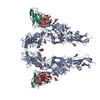[English] 日本語
 Yorodumi
Yorodumi- EMDB-21418: Leg region of the closed conformation of the human type 1 insulin... -
+ Open data
Open data
- Basic information
Basic information
| Entry | Database: EMDB / ID: EMD-21418 | |||||||||
|---|---|---|---|---|---|---|---|---|---|---|
| Title | Leg region of the closed conformation of the human type 1 insulin-like growth factor receptor ectodomain in complex with human insulin-like growth factor II | |||||||||
 Map data Map data | leg part of the close conformation | |||||||||
 Sample Sample |
| |||||||||
 Keywords Keywords | Type 1 insulin-like growth factor receptor / Insulin-like growth factor II / ectodomain receptor / tyrosine kinase / SIGNALING PROTEIN | |||||||||
| Function / homology |  Function and homology information Function and homology informationprotein kinase complex / insulin-like growth factor receptor activity / insulin-like growth factor binding / Signaling by Type 1 Insulin-like Growth Factor 1 Receptor (IGF1R) / protein transporter activity / IRS-related events triggered by IGF1R / transcytosis / FCERI mediated MAPK activation / protein localization to nuclear periphery / Activation of the AP-1 family of transcription factors ...protein kinase complex / insulin-like growth factor receptor activity / insulin-like growth factor binding / Signaling by Type 1 Insulin-like Growth Factor 1 Receptor (IGF1R) / protein transporter activity / IRS-related events triggered by IGF1R / transcytosis / FCERI mediated MAPK activation / protein localization to nuclear periphery / Activation of the AP-1 family of transcription factors / response to amino acid starvation / negative regulation of ribosomal protein gene transcription by RNA polymerase II / positive regulation of cellular response to amino acid starvation / mediator complex binding / insulin receptor complex / insulin-like growth factor I binding / positive regulation of protein-containing complex disassembly / insulin receptor activity / Oxidative Stress Induced Senescence / alphav-beta3 integrin-IGF-1-IGF1R complex / regulation of JNK cascade / dendritic spine maintenance / peptidyl-tyrosine autophosphorylation / insulin binding / amyloid-beta clearance / TFIID-class transcription factor complex binding / amino acid biosynthetic process / Respiratory syncytial virus (RSV) attachment and entry / insulin receptor substrate binding / positive regulation of RNA polymerase II transcription preinitiation complex assembly / positive regulation of transcription initiation by RNA polymerase II / SHC-related events triggered by IGF1R / cellular response to nutrient levels / phosphatidylinositol 3-kinase binding / negative regulation of MAPK cascade / insulin-like growth factor receptor signaling pathway / cellular response to amino acid starvation / insulin receptor binding / cellular response to glucose stimulus / phosphatidylinositol 3-kinase/protein kinase B signal transduction / receptor protein-tyrosine kinase / RNA polymerase II transcription regulator complex / cellular response to amyloid-beta / insulin receptor signaling pathway / positive regulation of cold-induced thermogenesis / protein autophosphorylation / DNA-binding transcription activator activity, RNA polymerase II-specific / protein tyrosine kinase activity / transcription regulator complex / sequence-specific DNA binding / RNA polymerase II-specific DNA-binding transcription factor binding / DNA-binding transcription factor activity, RNA polymerase II-specific / Extra-nuclear estrogen signaling / positive regulation of phosphatidylinositol 3-kinase/protein kinase B signal transduction / receptor complex / positive regulation of MAPK cascade / intracellular signal transduction / immune response / cilium / positive regulation of cell migration / RNA polymerase II cis-regulatory region sequence-specific DNA binding / DNA-binding transcription factor activity / axon / intracellular membrane-bounded organelle / positive regulation of cell population proliferation / chromatin binding / negative regulation of apoptotic process / nucleolus / negative regulation of transcription by RNA polymerase II / signal transduction / positive regulation of transcription by RNA polymerase II / ATP binding / identical protein binding / nucleus / membrane / plasma membrane Similarity search - Function | |||||||||
| Biological species |  Homo sapiens (human) / Homo sapiens (human) /  | |||||||||
| Method | single particle reconstruction / cryo EM / Resolution: 4.21 Å | |||||||||
 Authors Authors | Xu Y / Kirk NS | |||||||||
| Funding support |  Australia, Australia,  United Kingdom, 2 items United Kingdom, 2 items
| |||||||||
 Citation Citation |  Journal: Structure / Year: 2020 Journal: Structure / Year: 2020Title: How IGF-II Binds to the Human Type 1 Insulin-like Growth Factor Receptor. Authors: Yibin Xu / Nicholas S Kirk / Hariprasad Venugopal / Mai B Margetts / Tristan I Croll / Jarrod J Sandow / Andrew I Webb / Carlie A Delaine / Briony E Forbes / Michael C Lawrence /   Abstract: Human type 1 insulin-like growth factor receptor (IGF-1R) signals chiefly in response to the binding of insulin-like growth factor I. Relatively little is known about the role of insulin-like growth ...Human type 1 insulin-like growth factor receptor (IGF-1R) signals chiefly in response to the binding of insulin-like growth factor I. Relatively little is known about the role of insulin-like growth factor II signaling via IGF-1R, despite the affinity of insulin-like growth factor II for IGF-1R being within an order of magnitude of that of insulin-like growth factor I. Here, we describe the cryoelectron microscopy structure of insulin-like growth factor II bound to a leucine-zipper-stabilized IGF-1R ectodomain, determined in two conformations to a maximum average resolution of 3.2 Å. The two conformations differ in the relative separation of their respective points of membrane entry, and comparison with the structure of insulin-like growth factor I bound to IGF-1R reveals long-suspected differences in the way in which the critical C domain of the respective growth factors interact with IGF-1R. | |||||||||
| History |
|
- Structure visualization
Structure visualization
| Movie |
 Movie viewer Movie viewer |
|---|---|
| Structure viewer | EM map:  SurfView SurfView Molmil Molmil Jmol/JSmol Jmol/JSmol |
| Supplemental images |
- Downloads & links
Downloads & links
-EMDB archive
| Map data |  emd_21418.map.gz emd_21418.map.gz | 230 MB |  EMDB map data format EMDB map data format | |
|---|---|---|---|---|
| Header (meta data) |  emd-21418-v30.xml emd-21418-v30.xml emd-21418.xml emd-21418.xml | 15.9 KB 15.9 KB | Display Display |  EMDB header EMDB header |
| Images |  emd_21418.png emd_21418.png | 23.2 KB | ||
| Filedesc metadata |  emd-21418.cif.gz emd-21418.cif.gz | 6.7 KB | ||
| Archive directory |  http://ftp.pdbj.org/pub/emdb/structures/EMD-21418 http://ftp.pdbj.org/pub/emdb/structures/EMD-21418 ftp://ftp.pdbj.org/pub/emdb/structures/EMD-21418 ftp://ftp.pdbj.org/pub/emdb/structures/EMD-21418 | HTTPS FTP |
-Validation report
| Summary document |  emd_21418_validation.pdf.gz emd_21418_validation.pdf.gz | 478 KB | Display |  EMDB validaton report EMDB validaton report |
|---|---|---|---|---|
| Full document |  emd_21418_full_validation.pdf.gz emd_21418_full_validation.pdf.gz | 477.5 KB | Display | |
| Data in XML |  emd_21418_validation.xml.gz emd_21418_validation.xml.gz | 7 KB | Display | |
| Data in CIF |  emd_21418_validation.cif.gz emd_21418_validation.cif.gz | 8.1 KB | Display | |
| Arichive directory |  https://ftp.pdbj.org/pub/emdb/validation_reports/EMD-21418 https://ftp.pdbj.org/pub/emdb/validation_reports/EMD-21418 ftp://ftp.pdbj.org/pub/emdb/validation_reports/EMD-21418 ftp://ftp.pdbj.org/pub/emdb/validation_reports/EMD-21418 | HTTPS FTP |
-Related structure data
| Related structure data |  6vwjMC  6vwgC  6vwhC  6vwiC C: citing same article ( M: atomic model generated by this map |
|---|---|
| Similar structure data |
- Links
Links
| EMDB pages |  EMDB (EBI/PDBe) / EMDB (EBI/PDBe) /  EMDataResource EMDataResource |
|---|---|
| Related items in Molecule of the Month |
- Map
Map
| File |  Download / File: emd_21418.map.gz / Format: CCP4 / Size: 244.1 MB / Type: IMAGE STORED AS FLOATING POINT NUMBER (4 BYTES) Download / File: emd_21418.map.gz / Format: CCP4 / Size: 244.1 MB / Type: IMAGE STORED AS FLOATING POINT NUMBER (4 BYTES) | ||||||||||||||||||||||||||||||||||||||||||||||||||||||||||||
|---|---|---|---|---|---|---|---|---|---|---|---|---|---|---|---|---|---|---|---|---|---|---|---|---|---|---|---|---|---|---|---|---|---|---|---|---|---|---|---|---|---|---|---|---|---|---|---|---|---|---|---|---|---|---|---|---|---|---|---|---|---|
| Annotation | leg part of the close conformation | ||||||||||||||||||||||||||||||||||||||||||||||||||||||||||||
| Projections & slices | Image control
Images are generated by Spider. | ||||||||||||||||||||||||||||||||||||||||||||||||||||||||||||
| Voxel size | X=Y=Z: 1.06 Å | ||||||||||||||||||||||||||||||||||||||||||||||||||||||||||||
| Density |
| ||||||||||||||||||||||||||||||||||||||||||||||||||||||||||||
| Symmetry | Space group: 1 | ||||||||||||||||||||||||||||||||||||||||||||||||||||||||||||
| Details | EMDB XML:
CCP4 map header:
| ||||||||||||||||||||||||||||||||||||||||||||||||||||||||||||
-Supplemental data
- Sample components
Sample components
-Entire : Leg region of the open-leg conformation of the human type 1 insul...
| Entire | Name: Leg region of the open-leg conformation of the human type 1 insulin-like growth factor receptor ectodomain in complex with human insulin-like growth factor II |
|---|---|
| Components |
|
-Supramolecule #1: Leg region of the open-leg conformation of the human type 1 insul...
| Supramolecule | Name: Leg region of the open-leg conformation of the human type 1 insulin-like growth factor receptor ectodomain in complex with human insulin-like growth factor II type: complex / ID: 1 / Parent: 0 / Macromolecule list: all |
|---|---|
| Source (natural) | Organism:  Homo sapiens (human) Homo sapiens (human) |
| Molecular weight | Theoretical: 250 KDa |
-Macromolecule #1: Leucine-zippered human type 1 insulin-like growth factor receptor...
| Macromolecule | Name: Leucine-zippered human type 1 insulin-like growth factor receptor ectodomain type: protein_or_peptide / ID: 1 / Number of copies: 2 / Enantiomer: LEVO / EC number: receptor protein-tyrosine kinase |
|---|---|
| Source (natural) | Organism:  Strain: ATCC 204508 / S288c |
| Molecular weight | Theoretical: 108.937242 KDa |
| Recombinant expression | Organism:  |
| Sequence | String: EICGPGIDIR NDYQQLKRLE NCTVIEGYLH ILLISKAEDY RSYRFPKLTV ITEYLLLFRV AGLESLGDLF PNLTVIRGWK LFYNYALVI FEMTNLKDIG LYNLRNITRG AIRIEKNADL CYLSTVDWSL ILDAVSNNYI VGNKPPKECG DLCPGTMEEK P MCEKTTIN ...String: EICGPGIDIR NDYQQLKRLE NCTVIEGYLH ILLISKAEDY RSYRFPKLTV ITEYLLLFRV AGLESLGDLF PNLTVIRGWK LFYNYALVI FEMTNLKDIG LYNLRNITRG AIRIEKNADL CYLSTVDWSL ILDAVSNNYI VGNKPPKECG DLCPGTMEEK P MCEKTTIN NEYNYRCWTT NRCQKMCPST CGKRACTENN ECCHPECLGS CSAPDNDTAC VACRHYYYAG VCVPACPPNT YR FEGWRCV DRDFCANILS AESSDSEGFV IHDGECMQEC PSGFIRNGSQ SMYCIPCEGP CPKVCEEEKK TKTIDSVTSA QML QGCTIF KGNLLINIRR GNNIASELEN FMGLIEVVTG YVKIRHSHAL VSLSFLKNLR LILGEEQLEG NYSFYVLDNQ NLQQ LWDWD HRNLTIKAGK MYFAFNPKLC VSEIYRMEEV TGTKGRQSKG DINTRNNGER ASCESDVLHF TSTTTSKNRI IITWH RYRP PDYRDLISFT VYYKEAPFKN VTEYDGQDAC GSNSWNMVDV DLPPNKDVEP GILLHGLKPW TQYAVYVKAV TLTMVE NDH IRGAKSEILY IRTNASVPSI PLDVLSASNS SSQLIVKWNP PSLPNGNLSY YIVRWQRQPQ DGYLYRHNYC SKDKIPI RK YADGTIDIEE VTENPKTEVC GGEKGPCCAC PKTEAEKQAE KEEAEYRKVF ENFLHNSIFV PRPERKRRDV MQVANTTM S SRSRNTTAAD TYNITDPEEL ETEYPFFESR VDNKERTVIS NLRPFTLYRI DIHSCNHEAE KLGCSASNFV FARTMPAEG ADDIPGPVTW EPRPENSIFL KWPEPENPNG LILMYEIKYG SQVEDQRECV SRQEYRKYGG AKLNRLNPGN YTARIQATSL SGNGSWTDP VFFYVQAKTG YENFIHRMKQ LEDKVEELLS KNYHLENEVA RLKKLVGERS SSEQKLISEE DLN UniProtKB: Insulin-like growth factor 1 receptor, General control transcription factor GCN4 |
-Experimental details
-Structure determination
| Method | cryo EM |
|---|---|
 Processing Processing | single particle reconstruction |
| Aggregation state | particle |
- Sample preparation
Sample preparation
| Concentration | 0.1 mg/mL | ||||||||||
|---|---|---|---|---|---|---|---|---|---|---|---|
| Buffer | pH: 7.5 Component:
| ||||||||||
| Grid | Model: Quantifoil, UltrAuFoil, R1.2/1.3 / Material: GOLD / Mesh: 300 / Pretreatment - Type: GLOW DISCHARGE / Pretreatment - Time: 30 sec. / Details: 15mA current | ||||||||||
| Vitrification | Cryogen name: ETHANE / Chamber humidity: 100 % / Chamber temperature: 277 K / Instrument: FEI VITROBOT MARK IV | ||||||||||
| Details | IGFII:IGF-1R molar ratio 1.5:1 |
- Electron microscopy
Electron microscopy
| Microscope | FEI TITAN KRIOS |
|---|---|
| Specialist optics | Energy filter - Name: GIF Quantum LS |
| Image recording | Film or detector model: GATAN K2 SUMMIT (4k x 4k) / Detector mode: COUNTING / Digitization - Frames/image: 1-50 / Number grids imaged: 1 / Number real images: 4585 / Average exposure time: 10.0 sec. / Average electron dose: 50.0 e/Å2 |
| Electron beam | Acceleration voltage: 300 kV / Electron source:  FIELD EMISSION GUN FIELD EMISSION GUN |
| Electron optics | C2 aperture diameter: 50.0 µm / Illumination mode: FLOOD BEAM / Imaging mode: BRIGHT FIELD / Cs: 2.7 mm |
| Sample stage | Cooling holder cryogen: NITROGEN |
| Experimental equipment |  Model: Titan Krios / Image courtesy: FEI Company |
+ Image processing
Image processing
-Atomic model buiding 1
| Initial model | PDB ID: Chain - Source name: PDB / Chain - Initial model type: experimental model |
|---|---|
| Details | UCSF Chimera was used for the initial fitting and ISOLDE v 1.03b was using for flexible fitting. |
| Refinement | Space: REAL / Protocol: FLEXIBLE FIT |
| Output model |  PDB-6vwj: |
 Movie
Movie Controller
Controller


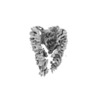



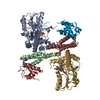

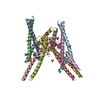

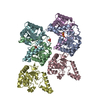


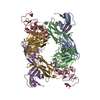









 Z (Sec.)
Z (Sec.) Y (Row.)
Y (Row.) X (Col.)
X (Col.)





















